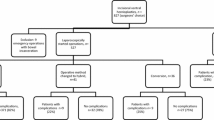Abstract
Background
Although still experimental, natural orifice translumenal endoscopic surgery (NOTES) aims to use the natural orifices for intraabdominal surgery. Pure transvaginal umbilical hernia repair has been reported. However, mesh protection devices were used to minimize mesh contamination during mesh insertion. The authors believe that before widespread implementation of this technique, more foundational research is indicated to establish the sterility of hernia mesh insertion through this route. This prospective study aimed to compare transvaginal ventral hernia mesh insertion sterility with laparoscopic trocar-site insertion sterility to establish baseline data to help promote the safety of NOTES tranvaginal hernia repair.
Methods
This was a prospective descriptive study (Canadian Task Force classification 2A). With institutional review board approval, 10 patients undergoing laparoscopic surgery for benign gynecologic disease were enrolled in the study. Atrium Prolite mesh (polypropylene monofilament) was inserted into the vagina before and after standard surgical preparation with 10 % povidone–iodine. As a control, mesh also was inserted through a prepped laparoscopic port site. The mesh was cultured for bacterial, fungal, and viral contamination. All patients received standard infection prophylaxis that included preoperative intravenous cefazolin and metronidazole.
Results
The unprepped vaginal canal was cultured and demonstrated normal multiorganism vaginal flora in all 10 cases. Of the 10 skin incision mesh samples, 3 (30 %) grew bacteria, including Staphylococcus lugdunensis, a potentially pathogenic organism. In contrast, none of the prepped vaginal mesh specimens yielded any growth of microorganisms or potential pathogens.
Conclusions
This study showed that a surgically prepped vaginal canal can be a sterile conduit for insertion of polypropylene mesh for transvaginal ventral hernia repair without the use of additional mesh protection. Surprisingly, the prepped vaginal conduit in our patients was more sterile than a prepped skin incision.




Similar content being viewed by others
References
Rattner D (2006) Introduction to NOTES white paper. Surg Endosc 20:185
Wood SG, Panait L, Bell RL, Duffy AJ, Roberts KE (2013) Pure transvaginal umbilical hernia repair. Surg Endosc 27(8):2966
Santos BF, Teitelbaum EN, Arafat FO, Milad MP, Soper NJ, Hungness ES (2012) Comparison of short-term outcomes between transvaginal hybrid NOTES cholecystectomy and laparoscopic cholecystectomy. Surg Endosc 26:3058–3066
Jacobsen GR et al (2010) Initial experience with transvaginal incisional hernia repair. Hernia 14:89–91
Powell B, Whang S, Bachman S, Astudillo A, Sporn E, Miedema B, Thaler K (2010) Transvaginal repair of a large chronic porcine ventral hernia with synthetic mesh using NOTES. JSLS 14:234–239
Roberts KE, Shetty S, Shariff AH, Silasi DA, Duffy AJ, Bell RL (2012) Transvaginal NOTES hybrid cholecystectomy. Surg Innov 19:230–235
Heniford BT, Ramshaw BJ (2000) Laparoscopic ventral hernia repair. Surg Endosc 14:419–423
Heniford BT, Park A, Ramshaw BJ, Voeller G (2000) Laparoscopic ventral and incisional hernia repair in 407 patients. JACS 190:645–650
Seifert H, Oltmanns D, Becker K, Wisplinghoff H, von Eiff C (2005) Staphylococcus lugdunensis pacemaker-related infection. Emerg Infect Dis 11(8):1283–1286
Disclosure
Andrew T. Bates,Tracy Capes, Rachna Krishan,Vincent LaBombardi, Giuseppe Pipia, Brian P. Jacob have no conflicts of interest or financial interests to disclose.
Author information
Authors and Affiliations
Corresponding author
Rights and permissions
About this article
Cite this article
Bates, A.T., Capes, T., Krishan, R. et al. The prepped vaginal canal may be a sterile conduit for ventral hernia mesh insertion: a prospective comparative study. Surg Endosc 28, 886–890 (2014). https://doi.org/10.1007/s00464-013-3242-7
Received:
Accepted:
Published:
Issue Date:
DOI: https://doi.org/10.1007/s00464-013-3242-7




